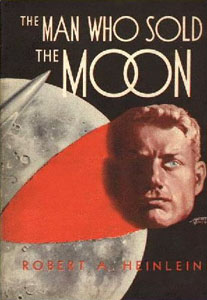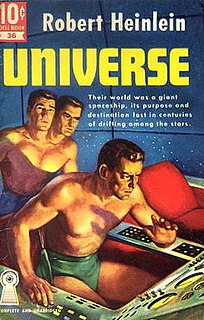
Robert Anson Heinlein was an American science fiction author, aeronautical engineer, and naval officer. Sometimes called the "dean of science fiction writers", he was among the first to emphasize scientific accuracy in his fiction, and was thus a pioneer of the subgenre of hard science fiction. His published works, both fiction and non-fiction, express admiration for competence and emphasize the value of critical thinking. His work continues to have an influence on the science-fiction genre, and on modern culture more generally.

Between Planets is a juvenile science fiction novel by American writer Robert A. Heinlein, originally serialized in Blue Book magazine in 1951 as "Planets in Combat". It was published in hardcover that year by Scribner's as part of the Heinlein juveniles.

Time for the Stars is a juvenile science fiction novel by American writer Robert A. Heinlein, published by Scribner's in 1956 as one of the Heinlein juveniles. The basic plot line is derived from a 1911 thought experiment in special relativity, commonly called the twin paradox, proposed by French physicist Paul Langevin.

Stranger in a Strange Land is a 1961 science fiction novel by American author Robert A. Heinlein. It tells the story of Valentine Michael Smith, a human who comes to Earth in early adulthood after being born on the planet Mars and raised by Martians, and explores his interaction with and eventual transformation of Terran culture.
"Delilah and the Space Rigger" is a science fiction short story by American writer Robert A. Heinlein. One of his Future History stories, it originally appeared in Blue Book in December 1949 and was reprinted in his collection, The Green Hills of Earth.
"Misfit" is a science fiction short story by American writer Robert A. Heinlein. It was originally titled "Cosmic Construction Corps" before being renamed by the editor John W. Campbell and published in the November 1939 issue of Astounding Science Fiction. "Misfit" was Heinlein's second published story. One of the earliest of Heinlein's Future History stories, it was later included in the collections Revolt in 2100 and The Past Through Tomorrow.
"The Green Hills of Earth" is a science fiction short story by American writer Robert A. Heinlein. One of his Future History stories, the short story originally appeared in The Saturday Evening Post, and it was collected in The Green Hills of Earth. Heinlein selected the story for inclusion in the 1949 anthology My Best Science Fiction Story. "The Green Hills of Earth" is also the title of a song mentioned in several of Heinlein's novels.
"The Long Watch" is a science fiction short story by American writer Robert A. Heinlein. It is about a military officer who faces a coup d'état by a would-be dictator.

"The Man Who Sold the Moon" is a science fiction novella by American author Robert A. Heinlein, written in 1949 and published in 1950. A part of his Future History and prequel to "Requiem", it covers events around a fictional first Moon landing in 1978 and the schemes of Delos D. Harriman, a businessman who is determined to personally reach and control the Moon.

The Green Hills of Earth is a collection of science fiction short stories by American writer Robert A. Heinlein, published in 1951, including short stories published as early as 1941. The stories are part of Heinlein's Future History. The title story is the tale of an old space mariner reflecting upon his planet of birth. According to an acknowledgement at the beginning of the book, the phrase "the green hills of Earth" is derived from a story by C. L. Moore.
Lazarus Long is a fictional character featured in a number of science fiction novels by Robert A. Heinlein. Born in 1912 in the third generation of a selective breeding experiment run by the Ira Howard Foundation, Lazarus becomes unusually long-lived, living well over two thousand years with the aid of occasional rejuvenation treatments. Heinlein "patterned" Long on science fiction writer Edward E. Smith, mixed with Jack Williamson's fictional Giles Habibula.

Future History is a series of stories created by Robert A. Heinlein. It describes a projected future of the human race from the middle of the 20th century through the early 23rd century. The term Future History was coined by John W. Campbell Jr. in the February 1941 issue of Astounding Science Fiction. Campbell published an early draft of Heinlein's chart of the series in the May 1941 issue.
"Solution Unsatisfactory" is a 1941 science fiction short story by American writer Robert A. Heinlein. It describes the US effort to build a nuclear weapon in order to end the ongoing World War II, and its dystopian consequences to the nation and the world.
"Space Jockey" is a science fiction short story by American writer Robert A. Heinlein. Part of his Future History series, it originally appeared in The Saturday Evening Post, April 26, 1947, and was collected in The Green Hills of Earth.
Torchship is a term used by Robert A. Heinlein in several of his science fiction novels and short stories to describe fictional rocket ships that can maintain high accelerations indefinitely, thus approaching the speed of light. The term has subsequently been used by other authors to describe similar kinds of fictional spaceships.
The science fiction writer Robert A. Heinlein (1907–1988) was productive during a writing career that spanned the last 49 years of his life; the Robert A. Heinlein bibliography includes 32 novels, 59 short stories and 16 collections published during his life. Four films, two TV series, several episodes of a radio series, and a board game derive more or less directly from his work. He wrote a screenplay for one of the films. Heinlein edited an anthology of other writers' SF short stories.

Pluto has been featured in many instances of science fiction and popular culture. Initially classified as a planet upon its discovery in 1930, Pluto has also received considerable publicity following a 2006 definition of planet decree and from the flyby of the New Horizons space probe in July 2015.

Jupiter's extensive system of natural satellites – in particular the four large Galilean moons – has been a common science fiction setting.
The works known as Heinlein juveniles are the young-adult novels written by Robert A. Heinlein. Scribner's published the twelve novels between 1947 and 1958; together they tell a single story of space exploration. A thirteenth work, Starship Troopers, was submitted to Scribner's but rejected and instead published by Putnam. A fourteenth novel, Podkayne of Mars, is often listed as a "Heinlein juvenile", although Heinlein himself did not consider it to be one.
The concepts of space stations and habitats are common in modern culture. While space stations have become reality, there are as yet no true space habitats. Writers, filmmakers, and other artists have produced vivid renditions of the idea of a space station or habitat, and these iterations can be categorized by some of the basic scientific concepts from which they are derived.









